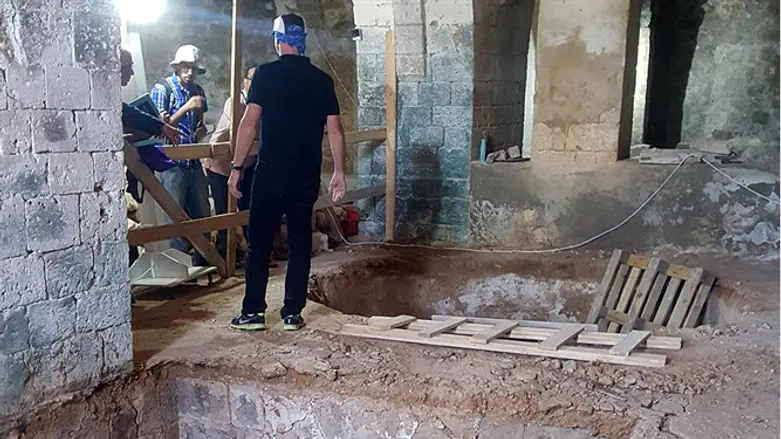
An impressive masbena, or soap-manufacturing factory, dating back to the 19th-century has been unexpectedly unearthed at the Uri Geller Museum now under construction in the Old City of Jaffa.
The factory includes several large underground chambers.
"Our work on the museum required, among other things, that we rewire the electricity in the ancient building," Uri Geller recounts. "When the electricity company began working on the structure, in tandem with inspectors from the Israel Antiquities Authority, we were amazed to uncover a large chamber with molded recesses. As the work proceeded, I noticed a pile of refuse on one side. I intuited that there was something hidden there. To the surprise of the Israel Antiquities Authority inspectors, an exceptional find was revealed: a factory for making soap (masbaneh in Arabic, Masbena in Hebrew)."
According to Dr. Yoav Arbel, a Jaffa expert with the Israel Antiquities Authority, "This previously unknown factory, whose original ownership remains unclear, is the second of its kind to have been discovered in Jaffa. The site was well preserved and included troughs for mixing raw materials for the soap, a large cauldron, a hearth, water cisterns and underground vaults that were used for storage. This find allows us to reconstruct the manufacturing process, and to draw comparisons with similar factories where the traditional manufacturing process has been perpetuated to this very day."
The production of soap from olive oil in the Land of Israel is an industry that was recorded as far back as the 10th-century. Soap became an important and lucrative product here, starting out in the Middle Ages and continuing as recently as the beginning of the 20th-century. Some of the soap was sold locally, while a large percentage was destined for export to regions within the Ottoman Empire - mainly for the Egyptian market.
The production center was in Shechem (Nablus), a town with abundant olive groves and where two traditional soap factories operate to this day. Soap was also manufactured on an industrial scale in Jaffa, Jerusalem, Gaza, and Lod. In addition to this find, there is one other soap factory known of in Jaffa: the Damiani Family Masbena, which operated in a large vault beneath the Jaffa Museum. That factory, which was active until 1948, is closed to visitors today, but can be glimpsed from a vantage point on Mifratz Shlomo Street. It is interesting to note that both Jaffa soap factories have nearly identical equipment.
One of the explanations for the commercial success of the Land of Israel's soap, compared to its European competitors, is in the raw material. European soap was made, inter alia, with pig fat – a substance shunned by Muslims and Jews – while in the Land of Israel other materials were used: The soap's core ingredient was olive fat, and to this was added soda ash derived from potash-rich saltwort plants, water and lime. Artisans would oversee the apportioning, preparation and mixing of the ingredients, all of which culminated in them being cooked in large vats or cauldrons for seven to 10 days. Next, the liquid soap would be poured onto special, lime-covered surfaces, where it would cool down and solidify for another 10 days until it could be cut into bars onto which the factory seal would be embossed. These would be stacked up and left to dry out for another two months. Only then could the soap be wrapped in paper for sale.
The soap factory utensils will be put on display at the Uri Geller Museum when it opens at 7 Mazal Arieh Street.
"The Uri Geller Museum will exhibit unique items and gifts that I collected and received over the years from notables such as Salvador Dali, Pablo Picasso, Albert Einstein and others," says Geller. "It will feature a Cadillac that was covered with around 2,000 spoons that had belonged to famous people, most of which I bent with my mind, and others which I obtained at auction. The Cadillac was previously exhibited at the Israel Museum and other museums in the United States and Europe."
Geller also plans, as an installation, the "World's Biggest Spoon," which will be 18 meters in length and will weigh 6 tonnes. "Without a doubt, the giant spoon and the museum in Jaffa will become an amazing tourist magnet, which is the goal," he says.
During a consultation at the museum site, former Tel Aviv District archaeologist Moshe Ajami suggested turning the newly discovered underground vaults into display areas for ancient items from the magi and sorcery. Geller agreed, and that project is slated to begin once the museum opens. Artist's renditions of the museum can be viewed on the museum's website.



